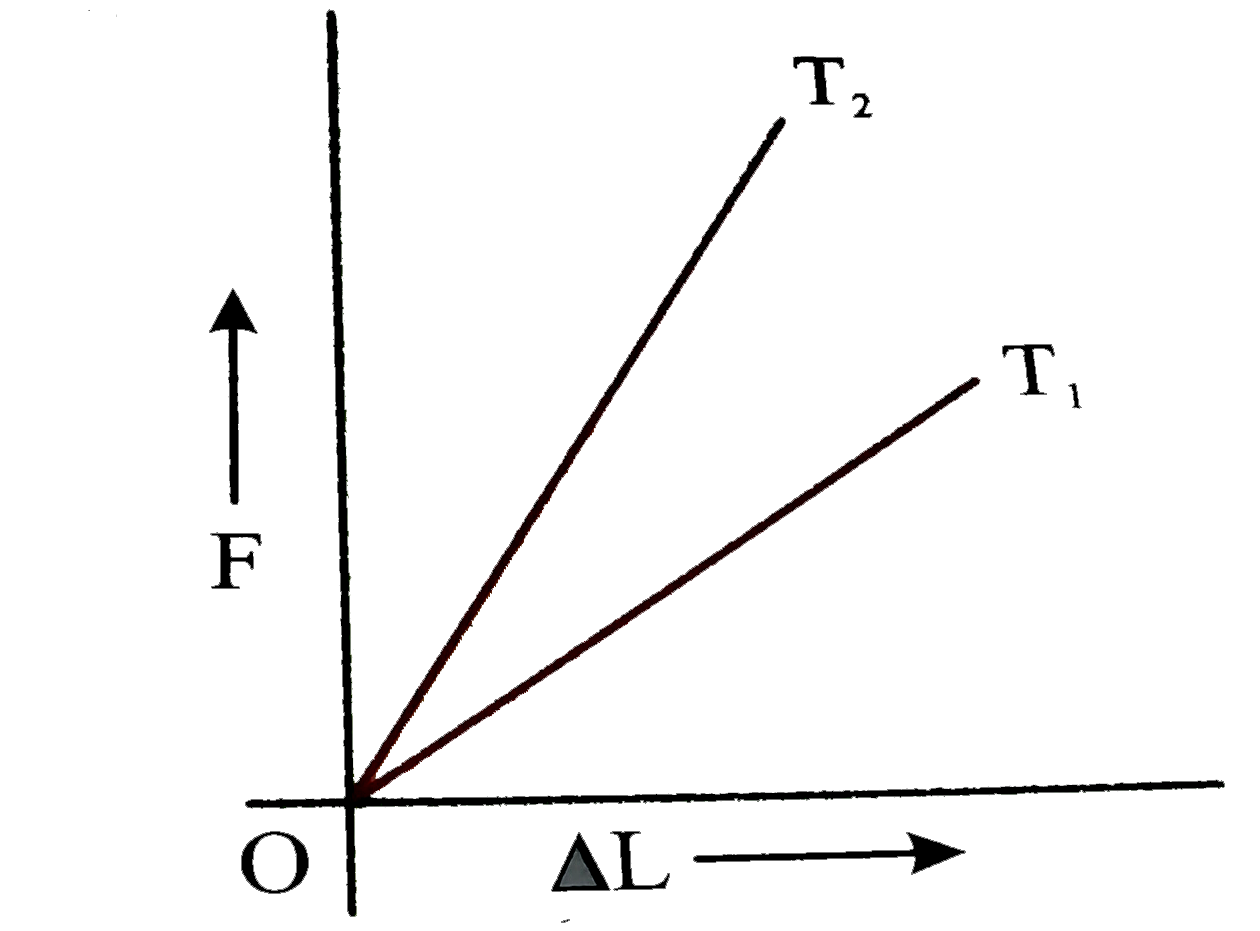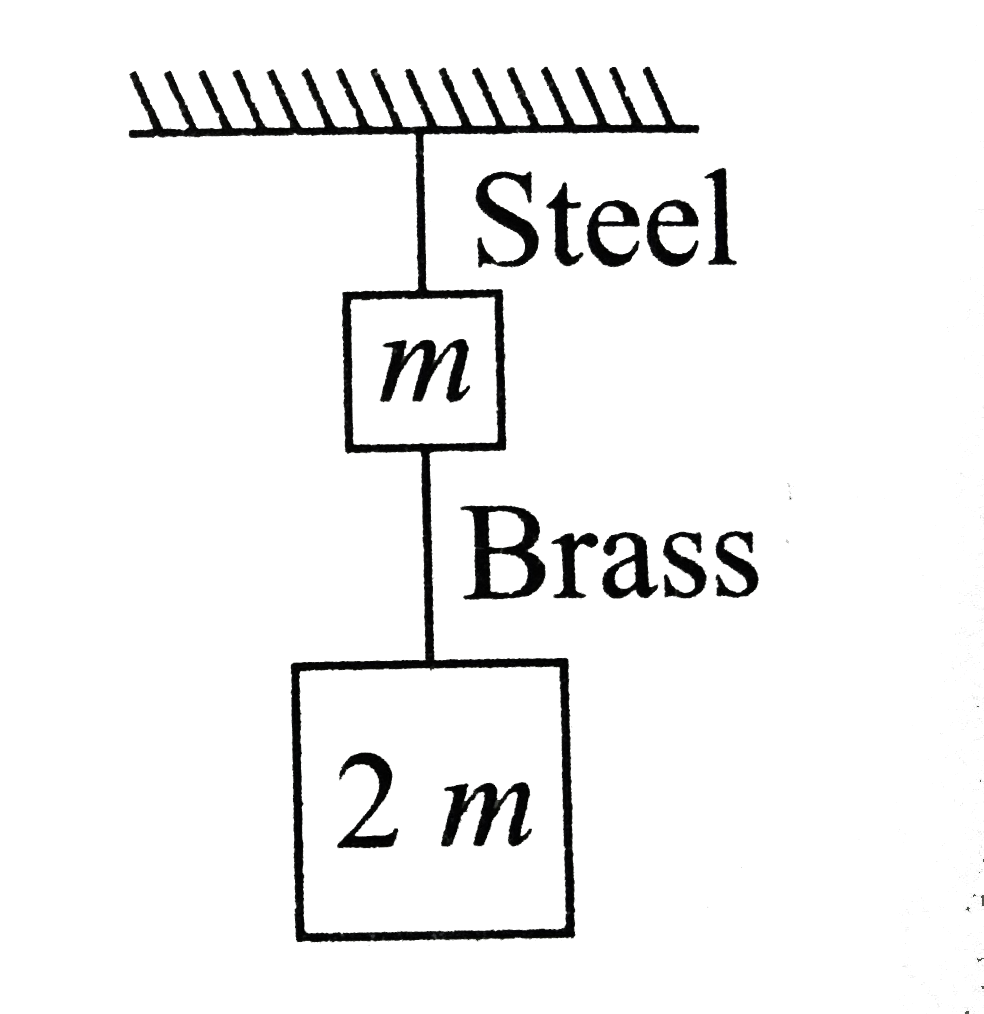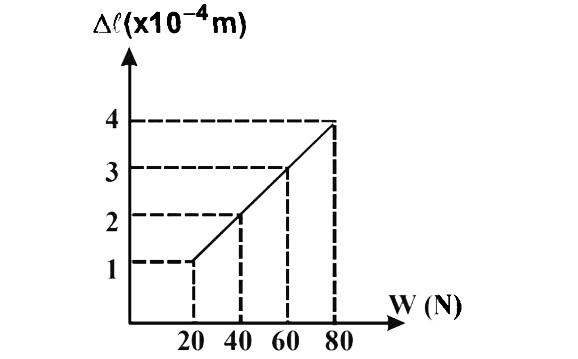Complete Solutions to PHYSICS of chapter MECHANICAL PROPERTIES OF SOLIDS of Class 11 book with complete answers and questions
| Class 11 | PHYSICS |
| Chapter | MECHANICAL PROPERTIES OF SOLIDS |
| DISHA | PHYSICS |
| Number Of Questions | 44 |
| Academic Year | 2023-24 |
Two wires A and B are of the same material. Their lengths are in the ratio 1 : 2 and the diameter are in the ratio 2 : 1. If they are pulled by the same force, then increase in length will be in the ratio
View Solution_E01_007_Q01.png)
The load versus elongation graph for four wires of the same material and same length is shown in the figure. The hinnest wire is represented by the line
View SolutionA spring of force constant `800N//m` has an extension of 5cm. The work done in extending it from 5cm to 15cm is
View SolutionA metal wire of length `L_1` and area of cross section A is ttached to a rigid support. Another metal wire of length `L_2` and of the same cross sectional area is attached to the free end of the first wire. A body of mass M is then suspended from the free end of the second wire, if `Y_1` and `Y_2` are the Young's moduli of the wires respectively the effective force constant of the system of two wires is
View SolutionThe approximate depth of an ocean is `2700m`. The compressibility of water is `45.4xx10^(-11)Pa^-1` and density of water is `10^3(kg)/(m^3)`. What fractional compression of water will be obtained at the bottom of the ocean?
View SolutionThe Young's modulus of steel is twice that of brass. Two wires of the same length and of the same area of cross section, one of steel and another of brass are suspended from the same roof. If we want the lower ends of the wires to be at the same level, then the weight added to the steel and brass wires must be in the ratio of
View SolutionChoose the wrong statement
View SolutionA copper wire of length `1.0` m and a steel wire of length` 0.5` m having equal cross-sectional areas are joined end to end. The composite wire is stretched by a certain load which stretches the copper wire by `1 mm.` If the Young’s modulii of copper and steel are respectively `1.0xx10^(11)Nm^(-2)"and"2.0xx10^(11)Nm^(-2),`
the total extension of the composite wire is:
View SolutionA cube at temperature `0^(@)C` is compressed equally from all sides by an external pressure P. By what amount should its temperature be raised to bring it back to the size it had before the external pressure was applied. The bulk modulus of the material of the cube is B and the coefficient of linear expansion is a
View SolutionThe graph shows the change `'Delta l'` in the length of a thin uniform wire used by the application of force `F` at different temperatures `T_(1)` and `T_(2)`. The variation suggests that

View SolutionIf the ratio of lengths, radii and Young's moduli of steel and brass wires in the figure are `a, b` and `c` respectively then the corresponding ratio of increase in their lengths is

View SolutionYoung's modulus of brass and steel are `10 xx 10^(10) N//m^(2)` and `2 xx 10^(11) N//m^(2)`, respectively. A brass wire and a steel wire of the same length are extended by `1 mm` under the same force. The radii of the brass and steel wires are `R_(B)` and `R_(S)` respectively. Then
View SolutionSteel ruptures when a shear of`3.5xx10^(8)Nm^(-2)` is applied. The force needed to punch a `1 cm` diameter hole in a steel sheet `0.3 cm` thick is nearly:
View SolutionA ball falling in a lake of depth `400 m` has a decrease of `0.2%` in its volume at the bottom. The bulk modulus of the material of the ball is `("in"Nm^(-2))`
View SolutionA circular tube of mean radius `8 cm` and thickness `0.04 cm` is melted up and recast into a solid rod of the same length. The ratio of the torsional rigidities of the circular tube and the solid rod i
View SolutionTwo wires are made of the same material and have the same volume. However wire 1 has cross-sectional area A and wire 2 has cross-sectional area 3A. If the length of wire 1 increases by `Deltax` on applying force F, how much force is needed to stretch wire 2 by the same amount?
View SolutionIn materials like aluminium and copper, the correct order of magnitude of various elastic modului is:
View SolutionWhat percent of length of a wire will increses by applying a stress fo `1kg. Wt//mm^(2)` on it.
`[Y = 1xx10^(11) Nm^(-2) "and" 1 kg wt = 9.8N]`
View SolutionAn elastic spring of unstretched length `L` and force constant `K` is stretched by amoun t `x` .It is further stretched by another length `y` The work done in the second streaching is
View SolutionTwo, spring P and _(Q) of force constants `K_(p)` and `k_(Q)(k_(Q)=(kp)/2)`are stretched by applying forces of equal magnitude. If the energy stored in` _(Q) ia E,` then the energy stored in P is
View SolutionThe pressure that has to be applied to the ends of a steel wire of length 10cm to keep its length constant when its temperature is raised by `100^@C` is : (For steel Young's modulus is `2xx10^11 Nm^-2` and coefficient of thermal expansion is `1.1xx10^-5K^_1`)
View SolutionA steel ring of radius r and cross section area A is fitted on to a wooden disc of radius `R(Rgtr)`. If Young's modulus be R, then the force with which the steel ring is expanded is
View SolutionTwo wires A and B of same material and of equal length with the radii in the ratio `1 : 2` are subjected to identical loads. If the length of A increases by `8 mm,` then the increase in length of B is
View SolutionA material has Poisson ratio `0.5`. If a rod of material has a longitudinal strain `2xx10^-3`, the percentage change in volume is :
View SolutionThe upper end of a wire of diameter 12mm and length 1m is clamped and its other end is twisted through an angle of `30^(@)`. The angle of shear is
View SolutionThe pressure on an object of bulk modulus B undergoing hydraulic compression due to a stress exerted by surrounding fluid having volume strain `((DeltaV)/(V))^(2)`
View SolutionA structural steel rod has a radius of 10 mm and length of 1.0 m. A 100 kN force stretches it along its length. Young’s modulus of structural steel is `2xx10^11Nm^(_2)`. The percentage strain is about
View SolutionA beam of metal supported at the two edges is loaded at the centre. The depression at the centre is proportional to

View SolutionWhen a 4 kg mass is hung vertically on a light string that obeys Hooke's law, the spring stretches by 2 cm. The work required to be done by an external agent in stretching this spring by 5 cm will be (`g=9.8(metrs)/(sec^2)`)
View SolutionThe length of a metal wire is `l_(1)` when the tension in it is `T_(1)` and is `l_(2)` when the tension is `T_(2)`. Then natural length of the wire is
View SolutionThe bulk moduli of ethanol, mercury and water are given as `0.9, 25 `"and "`2.2` respectively in units of `10^(9)` `Nm^(-2). For a given value of pressure, the fractional compression in volume is `(DeltaV)/V`Which of the following statements abou `(DeltaV)/V`for these three liquids is correct ?
View SolutionThe graph given is a stress-strain curve for

View SolutionA metal rod of Young's modulus `2xx10^(10)Nm^(-2)` undergoes an elastic strain of `0.06%.` The energy per unit volume stored in `Jm^(-3)`is
View SolutionTwo wires of the same material and length but diameters in the ratio `1:2` are stretched by the same force. The potential energy per unit volume for the two wires when stretched will be of the ratio.
View SolutionThe length of an elastic string is a metre when the longitudinal tension is 4 N and b metre when the longitudinal tension is 5 N. The length of the string in metre when the longitudinal tension is 9 N is
View SolutionA force of 103 newton, stretches the length of a hanging wire by 1 millimetre. The force required to stretch a wire of same material and length but having four times the diameter by 1 millimetre is
View SolutionA steel wire of length l and cross sectional area A is stretched by 1 cm under a given load. When the same load is applied to another steel wire of double its length and half of its cross section area, the amount of stretching (extension) is
View SolutionThe adjacent graph shows the estension `(Deltal)` of a wire of length 1m suspended from the top of a roof at one end and with a load W connected to the other end. If the cross-sectional area of the wire is `10^-6m^2`, calculate the Young's modulus of the material of the wire.

View SolutionIf a rubber ball is taken at the depth of 200 m in a pool, its volume decreases by`0.1%` If the density of the water is `1xx10^(3)Kg//m^(3)"and"g=10ms^(2), then the volume elasticity in N//m2 will be
View SolutionA ball falling in a lake of depth `200 m` shows a decrease of `0.1% ` in its volume at the bottom. The bulk modulus of elasticity of the material of the ball is (take `g = 10 ms^(-2)`)
View SolutionThe diagram shows a forc-extension graph for a rubber band. Consider of the following statements

I. It will be easier to compress this rubber than expand it
II. Rubber does not return to its original length after it is streched
III. The rubber band will get heated id it is streched and realeased
Which of these can be deduced from the graph
View SolutionThe Poisson’s ratio of a material is 0.5. If a force is applied to a wire of this material, there is a decrease in the cross-sectional area by 4%. The percentage increase in the length is:
View SolutionCopper of fixed volume `V` is drawn into wire of length l. When this wire is subjected to a constant force F, the extension produced in the wire is `trianglel`. Which of the following graphs is a straight line?
View SolutionWhen a 4 kg mass is hung vertically on a light string that obeys Hooke's law, the spring stretches by 2 cm. The work required to be done by an external agent in stretching this spring by 5 cm will be (`g=9.8(metrs)/(sec^2)`)
View Solution
PHYSICS questions and complete solutions for chapter MECHANICAL PROPERTIES OF SOLIDS of DISHA PHYSICS (HINGLISH) of Class 11